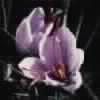|
For the finest produce, see our Saffron Shelf, with highest grade Coupe (Sargol) threads and powder around £0.90/€1,30/$1.70 per gram. (1g is sufficient for 20-25 servings of rice at normal usage; typical retail price £4, €6 or $7 per gram). Cooking Immerse the equivalent of 5-6 saffron threads per serving in a cup of hot water, cover, and allow to steep for 20-30 minutes; add the infusion (including threads) to the rice, then cook as normal. Citrous juices may also be used, and - provided these flavours do not detract from the recipe - adding a little vinegar or spirits will greatly accelerate the steeping process. Alternatively, the threads can be added dry, mixed in well and 'steamed' into the rice or potato dish, keeping covered for 15-20 minutes before serving. Powdered saffron (freshly-ground or purchased), on the other hand, releases its flavour much more quickly than threads, and can be sprinkled in a few minutes before serving, at the rate of 40-50 milligrams per person (about 1/10th of a teaspoonful for 4 people). Powder is more convenient if doesn't matter that individual filaments don't appear in the prepared dish, but see note on shelf life. The World's Most Precious Spice Saffron is obtained from the stigma (the long, branched inner stalk) of the flower crocus sativus (sativus = 'cultivated'). High quality Sargol (or 'coupe') contains only the cut branches of the stigma; these 'threads' have a rich red colour - mainly due to the presence of the pigment crocine. After harvesting, the stigmas are dried rapidly ('toasted') down to a moisture content of about 2%; this process not only preserves the freshness of both essence and colour, but also makes it possible to keep saffron for many years - provided the threads are kept cool, dry and out of direct light. Ground or powdered saffron tends to have a shorter shelf life than whole threads under most conditions of storage, because a greater surface area is exposed to the unfavourable effects of moisture and light, etc - particularly in the environment of a kitchen. Pushali saffron (or 'mancha') contains varying proportions of the style (the yellow stalk connecting the stigma to the centre of the flower): the colouring power and flavour of these mixes is much less intense than pure sargol. Since consumers need to know what grade of produce is on offer, an International Standard (ISO-3632) regulates the quality and labelling of the various saffrons, regardless of origin; within this code, the main criterion is minimum colouring strength, which is based on a photo-analysis of crocine content - ranging from an index value of 110 for lower pushali mixes, and between 190 to over 250 for the top sargols. A yield of just 1kg per hectare (about 175,000 individual flower heads!), makes saffron easily the most expensive of all the spices. As well as for its intense colour, saffron has been prized for its flavouring and aromatic qualities since antiquity, with the gathering and separating process, in many respects, remaining as labour-intensive as it was then. Total world production amounts to less than 220 tonnes annually (c.f. 300 thousand tonnes of pepper), of which Iran (ancient Persia) accounts for more than 80%; other important growing regions are Spain, Morocco, Greece, and the Kashmir. Return to top of page
|


